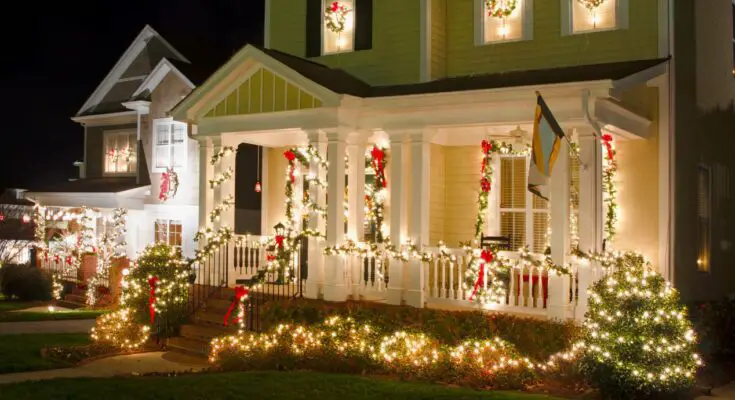Decorative lighting has become essential in home design, extending far beyond the traditional holiday season. Homeowners are increasingly seeking ways to enhance their property’s aesthetic appeal and create a welcoming atmosphere throughout the year. This comprehensive guide will explore the world of festive illumination, offering insights into various lighting options, installation techniques, and creative ideas to transform your home’s exterior.
The Evolution of Outdoor Lighting
From Seasonal to Year-Round
Historically, decorative outdoor lighting was primarily associated with holidays, particularly Christmas. However, the trend has shifted towards maintaining an inviting and visually appealing exterior throughout the year. This change reflects a growing desire among homeowners to maximize their property’s curb appeal and create a warm, welcoming environment for both residents and visitors.
Technological Advancements
The evolution of lighting technology has played a crucial role in this shift. LED lights, smart control systems, and energy-efficient options have made maintaining decorative lighting year-round more practical and cost-effective. These advancements have opened up new possibilities for creative and customizable lighting designs.
Types of Decorative Outdoor Lighting
String Lights
String lights remain a popular choice for their versatility and charm. They can be used to:
- Outline architectural features
- Create a canopy effect over patios or decks
- Wrap around trees and shrubs
Landscape Lighting
Landscape lighting enhances the natural beauty of your property while providing functional illumination. Options include:
- Path lights
- Spotlights for trees or architectural elements
- Well lights for ground-level illumination
Architectural Lighting
This type of lighting is designed to highlight the structural features of your home. Common applications include:
- Soffit lighting
- Gable lighting
- Wall washing techniques
Permanent Lighting Solutions
For those seeking a more permanent solution, professionally installed lighting systems offer convenience and versatility. These systems can be programmed to change colors and patterns, allowing homeowners to adapt their lighting to different seasons and occasions without the hassle of frequent installation and removal. For example, permanent Christmas lights Utah providers offer year-round options that can be customized for various holidays and events.
Design Principles for Outdoor Lighting
Balance and Symmetry
When planning your outdoor lighting, consider the overall balance of your property. Aim for symmetry in your design to create a cohesive look. For example, if you illuminate one side of your entryway, ensure the other side receives equal treatment.
Layering Light
Effective outdoor lighting often involves layering different types of light:
- Ambient lighting for overall illumination
- Task lighting for specific areas like walkways or outdoor kitchens
- Accent lighting to highlight focal points
Color Temperature
The color temperature of your lights can significantly impact the mood of your outdoor space:
| Color Temperature | Mood |
| Warm White (2700-3000K) | Cozy and inviting |
| Cool White (3500-4100K) | Clean and modern |
| Daylight (5000-6500K) | Bright and energizing |
Installation Considerations
Professional vs. DIY
While some lighting projects can be DIY-friendly, others may require professional installation. Consider factors such as:
- Electrical work required
- Complexity of the design
- Time and effort involved
Safety First
When installing outdoor lighting, safety should be a top priority. Ensure that:
- All electrical connections are properly sealed and weatherproof
- Lights and wires are securely fastened
- Pathways and stairs are well-lit to prevent accidents
Energy Efficiency
To keep energy costs manageable, consider:
- Using LED lights, which consume less power and have a longer lifespan
- Installing timers or motion sensors to control when lights are on
- Opting for solar-powered lights where appropriate
Creative Ideas for Year-Round Lighting
- Create a starry night effect with string lights on your patio ceiling
- Use color-changing lights to match different holidays or seasons
- Illuminate water features like fountains or ponds for a magical effect
- Design a moonlighting effect by placing lights high in trees
- Incorporate lighting into outdoor art installations or sculptures
Maintenance and Upkeep
To ensure your outdoor lighting continues to enhance your property:
- Regularly inspect wires and connections for damage
- Clean fixtures to maintain optimal brightness
- Replace bulbs promptly when they burn out
- Adjust lighting angles seasonally to account for changes in foliage
Environmental Considerations
When designing your outdoor lighting, be mindful of its impact on the environment:
- Use fixtures that direct light downward to reduce light pollution
- Consider the effect on local wildlife, especially in rural areas
- Opt for energy-efficient bulbs and solar options where possible
Wrapping Up: Illuminating Your Home’s Potential
Decorative outdoor lighting has evolved from a seasonal tradition to a year-round home enhancement. By understanding the various types of lighting available, applying design principles, and considering factors like installation and maintenance, you can create a stunning and inviting exterior that shines throughout the year. Whether you opt for a professional installation or a DIY approach, the right lighting can transform your property, increasing its beauty, safety, and value. As you embark on your lighting project, remember that the goal is to create a welcoming atmosphere that reflects your style and enhances your home’s natural charm.



